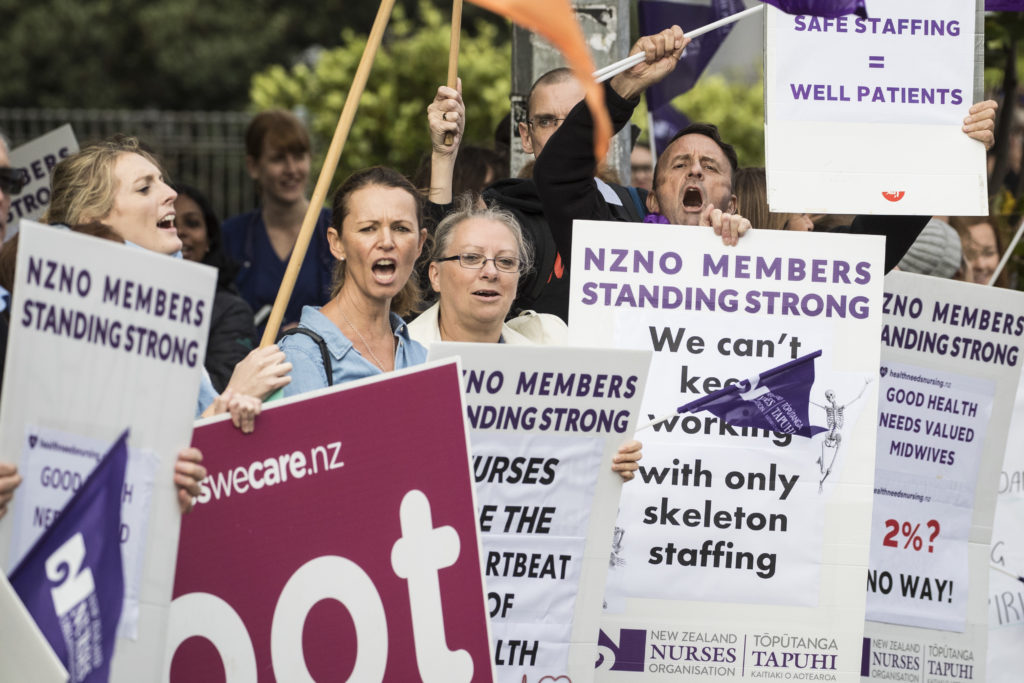Since our beginning twenty-one years ago, Socialist Review has been dedicated to trying to build workers’ power on these islands. That has meant taking a realistic look at the state of our forces. And, for most of our existence, a realistic look has been a sobering one: low strike levels, union membership shrinking, workers’ confidence decreasing. The job of our magazine, much of the time, has been to document a retreat and to make arguments for how we might rebuild.
That situation has changed. The mass strike of health workers last July – backed up by huge rallies and marches in Auckland and elsewhere – was the inspiration for a growing wave of strikes through 2018. Health workers took strike action for the first time in almost thirty years and, although they fell short of winning all their needed demands, they have made resolute industrial action thinkable again. And they have put the government on notice around crucial questions: pay, staffing, equal pay. Nurses have changed the reality of industrial relations and, most important of all, they have made strikes part of the popular imagination again. It is hard to believe that the primary teachers’ strikes in 2018 would have been as successful had the nurses not already set out along that road.
For all the inspiration of the nurses’ struggle, however, it ended in a messy and, we argue, unnecessarily compromised settlement. NZNO members were let down by the foot-dragging and misleadership of their officials, who recommended bad deal after bad deal until, ground down, 64 percent of voters in the union’s final ballot agreed to the District Health Boards’ latest offer. Many crucial issues for rank-and-file nurses – particularly around pay and staffing – remain unresolved. If the union’s negotiators had had a touch of the fight of their members who knows what might have been achieved?
So this dispute offers important lessons for all of us interested in winning workers’ power. Our job at Socialist Review is not just to preach our own vision of socialism. It is also to listen, to learn, to reflect on and to generalise from the experiences of the class. ISO members, attending nurses’ protests, strikes and forums, had a chance to meet with and talk to activists leading this struggle. Their successes – and failures – challenge all of us trying to rebuild the union movement.
This article offers some first reflections on the lessons coming out of the nurses’ struggle, generated out of conversations with those involved in the struggle and articles written during the dispute itself. The conversation and debate over this important fight is bound to continue as our confidence to take strike action builds.
Unions don’t need to be liked – they need to be noticed.
“Raising expectations (and raising hell)”: that’s how US activist Jane McAlevey described her job as an organiser rebuilding American trade unions. When unions were at their most powerful in this country – and when we had won pay protection and employment security for many – they were also widely reviled in the mainstream media and by politicians. Raising hell for workers makes you enemies amongst the rich.
For too long, however, much of our movement’s leadership has argued that, as we grew ever weaker, it’s important for us to be liked by employers and approved of in the media. “The narrative”, this line goes, is all important. Council of Trade Unions Secretary Sam Huggard claimed in August that “good employers” will welcome collective bargaining “as a way to enhance their business.” The Public Service Association lists “partnership agreements with employers” as the second reason to join them.
This case has always been wrong. Employers fear the disruption of collective action, and have treated our movement with contempt when that fear went. We have three decades of defeat to show for the class-collaborationist strategy. But, through these decades, the alternative has seemed abstract.
The nurses made it concrete. They raised hell. Picket lines, protests outside of hospitals, marches, votes defying the DHBs: none of this brought praise from the government or the media, but it did draw public support when the public was asked to show solidarity. Mike Hosking might have attacked the nurses, but this just showed how out of touch he was.
So lesson one is simple, but hard: we need to fight.
Say yes to voting no
By voting down bad offers, the nurses forced the government into finding more money. And they challenged the myth that “the economy” is something neutral and separate from the realm of politics. Experts and the bosses always start negotiations by saying there is no more money. Too often we believe them. The nurses showed that we can push back and participate as actors in the economic debate.
Lesson two: we need to make demands for what our side needs, and not just settle for keeping up with inflation.
From Facebook to face-to-face
Many commentators have focused on the role of social media in this dispute. And it played an important role. The Nurse Florence page was followed by over 45,000 people. 20,000 ‘like’ the NZNO official page. Facebook allowed everyday nursing stories and the lived reality of working in an understaffed, stretched, under-appreciated health sector to connect with tens of thousands of people. This was a powerful tool for going around the TV, radio and the newspapers to connect directly with other workers. And it fostered a spirit of solidarity between rank-and-file nurses.
So Facebook certainly mattered. And Nurse Florence played a role in galvanizing opposition to each of the bad deals recommended by the union officials. You could follow arguments for voting “no” in real time, and nurses gained confidence to challenge the lead of their officials.
But Facebook organizing needs face-to-face organizing, kanohi ki te kanohi. All sorts of ideas jostled against each other online, and the Nurse Florence “NZ Please Hear Our Voice” page hosted posts pushing for individualist and anti-union positions. This was always a dead-end, and the membership numbers show that the vast majority of workers in the industry back trade unionism, but the anti-union postings allowed dissatisfaction and frustration to go off in all sorts of directions, many of them unhelpful.
A contrast with successful US teachers’ strikes in February and March is striking. There too rank-and-file teachers, especially in West Virginia, used Facebook groups to go around a defeatist official leadership, and to connect teachers looking to resist. But their next step was to organise mass meetings of teachers to deliberate collectively and to coordinate wildcat strike action. Socialist teacher Dana Blanchard, in her analysis of the varying fortunes of teachers’ strikes in West Virginia, Oklahoma, Kentucky, and Arizona, found Facebook played a role in all these disputes. But what separated the West Virginia win from the others was the force of face-to-face rank and file networking and organising.
Some health worker unionists have already taken up that challenge. The Health Sector Workers Network is drawing together activists and strategising. The NZNO Members Action Group held a hui in August to debate lessons from the strike, with spokesperson Danni Wilkinson telling Nursing Review that part of the Group’s frustration is with the “partnership” approach the NZNO has long pursued with the employers of the DHBs. “I guess we are at the point where there have been a lot of people talking,” she said, “and it’s time to put up or shut up – if you are just going to sit in the background and whinge, whine and complain but not actually participate in creating the change that you want, then stop your whingeing.”
Lesson three: social media helps, but is not a substitute for, old-fashioned methods of talking, organising and debating face-to-face and in collectives. And lesson four: stay union. “Unity is strength” is not just a slogan, it’s a basic reality.
With and against the officials
The union leadership had no desire to push for a confrontation, recommending bad offer after bad offer. They were clearly out of touch with the anger of the rank and file of nurses. NZNO officials argued in favour of the latest offer to media while nurses were still voting, undermining the democratic process inside the union. The (unelected) top paid staff reflect the dominant ‘partnership’ thinking that has hampered our union movement for so long – NZNO chief executive Memo Musa was once a chief executive of Whanganui DHB, so a boss! Industrial Services Manager Cee Payne and others spoke with visible reluctance each time an offer was rejected.
These are not just personal failings of particular individuals, and ours is not a personalised attack. And they are not failings that can be avoided by individual activists, no matter how dedicated, taking up leadership positions if they are bound by the censorship of “collective responsibility” rules. The partnership approach reflects a political position of the union bureaucracy.
Lesson five: to counter bureaucratic conversatism, we need a political position of our own, and a renewed network of rank-and-file trade unionists agitating on the job.
We are on good terrain for more nurses strikes should the government not provide for equal pay. There are staff shortages: at least 100 vacancies at both Waikato and Counties-Manukau DHBs in September last year. Nurses are in a strong position to organise again. The strike of 2018 may come to be seen as an opening in a round of battles announcing the return of union strength to the sector.









